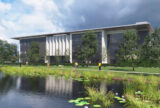Employee Wellbeing Can Be Literally Built Into a Workplace

St. Modwen’s second partner perspective story explores how wellness and mindfulness are becoming increasingly top-of-mind criteria for occupiers. Alastair Longden is Associate Director at UMC Architects and collaborator with St. Modwen on a new set of design principles focusing on how commercial spaces will be experienced by its end users.
UMC Architects and St. Modwen are at the forefront of architecture firms and developers who are stepping away from the pre-existing notion of an industrial unit, which might take the form of an open-plan warehouse where office space is something of an afterthought, and towards more holistically designed spaces which promote getting out and being active as a way of practicing self-care during the workday.
“Historically these deals are based on square footage; the bigger the building, the bigger the income for the developer,” says Longden. “But the mindset has recently changed, and they’re actually dedicating more space on the master plan to open areas, outdoor gyms, trim trails, shower facilities, quiet grassed areas; that’s all space that’s not lettable, there’s no direct income there, but what it does is it creates a holistic park. We’re looking to create an exciting, vibrant place to work, rather than the traditional industrial estate.”
This new kind of workspace is becoming a must-have among occupiers, thanks to the increasingly popular WELL standard, an accreditation focused on advancing health and wellbeing in buildings. Incorporating these kinds of criteria can make a property much more desirable when it’s being built speculatively.
“These buildings might become an Amazon distribution centre, or Gymshark’s latest gym, there’s a whole host of different uses, and they are all happily housed within these buildings,” says Longden. “Flexibility is really key. Right now, even with COVID, the market is still going strong with these units, there’s a lot of competition. When you’re building speculatively, it can be the smallest thing that brings an occupier to your unit and not the one down the road, and that’s why we’re so keen to labour over every detail.”
There’s even an argument to be made that these human-touch details, whether that’s a running track or a quiet green area, help occupiers to position themselves as having the kind of company culture that makes them more attractive as employers. Which in turn will then contribute to driving demand for more holistic, employee-focused industrial parks. Longden sees this as the new gold standard for workspaces.
“Now, as architects, we’re allowed to spread our wings a bit more,” he says. “It’s a really exciting thing to be involved in, and as designers we’re able to really liaise with landscape architects and the engineers. These projects can be quite contentious, so we’re always standing back and looking for opportunities to build links with the public, and do a much more thorough analysis in order to ensure that these parks sit comfortably within their environment and local community.”
This often means walking a figurative tightrope between the financial requirements of a scheme, and the criteria laid out in the emerging Park Code. “Through good design, we can find pockets of land that have been left fallow, and we can repurpose those into outdoor amenities… Some of these sites may have 10 units on them, so it creates a kind of community spirit as well.”
It is Longden’s hope, as well as the hope of St. Modwen and UMC Architects, that more developers will begin to see the value in compromising on sheer square footage in favour of creating places where people actually want to work. “Bigger is not necessarily better,” he says. “Better is better.”
Find out more about St. Modwen Industrial & Logistics, here ?



